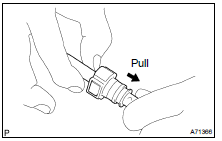Toyota Highlander Service Manual: Precaution
CAUTION: Before working on the fuel system, disconnect the negative (-) terminal cable from the battery.
Do not smoke or be near an open flame when working on the fuel system.
Keep gasoline away from rubber or leather parts.
1. DISCHARGE FUEL SYSTEM PRESSURE
CAUTION: Do not disconnect any part of the fuel system until you have discharged the fuel system pressure.
Even after discharging the fuel pressure, place a shop rag over fittings as you separate them to reduce risk of fuel spray on yourself or in the engine compartment.

(a) Remove the circuit opening relay from the R/B sub-assy.
(b) Start the engine. After the engine has stopped, turn the ignition switch OFF.
HINT: There is a case that DTC P0171 (system to lean) is output.
(c) Check that the engine does not start.
(d) Remove the fuel tank cap, and allow the air out of the fuel tank.
(e) Reinstall the circuit opening relay.
2. FUEL SYSTEM
(a) When disconnecting the high fuel pressure line, a large amount of gasoline will spill out, so observe these procedures.

- Perform the step 2 to prevent gasoline from spilling out.
- Put a container under the connection.
- Disconnect the fuel pump tube (see page 11-55 ).
- Drain the fuel remaining inside the fuel pump tube.
- To protect the disconnected fuel pump tube from damage and contamination, cover it with a vinyl bag.
(b) Observe the following precautions when removing and installing the fuel injectors.

- Never reuse O-rings.
- When installing a new O-ring on the injector, be careful not to damage it.
- Coat new O-rings with grease or gasoline before installing. Never use engine oil, gear oil or brake oil.

(c) Install the injector to the delivery pipe and cylinder head, as shown in the illustration. Before installing the injector, be sure to apply grease or gasoline on the place where the delivery pipe touches the O-ring of the injector.
(d) Observe these precautions when disconnecting the fuel tube connectors.

- Remove the fuel pipe clamp from the connector.
- Check for dirt or mud on the pipe and around the connector before disconnection. Clean if necessary.

- Disconnect the connector from the hose while pinching part A with fingers, as shown in the illustration.

- If the connector and the pipe are stuck, pinch the fuel pipe, push and pull the connector to disconnect it and pull it out. Do not use any tools.
- If dirt or any other substance is found on the sealing surface that might interfere with the seal, clean the area thoroughly before assembly.

- To protect the disconnected pipe and connector from damage and contamination, cover it with a vinyl bag.
(e) Observe these precautions when connecting the fuel tube connector.

- Check that there is no damage or contamination in the connected part of the pipe.
- Align the axis of the connector with the axis of the pipe. Push the pipe into the connector until the connector makes a "click" sound. If the connection is tight, apply little amount of fresh engine oil on the tip of the pipe.

- After having finished the connection, check if the pipe and the connector are securely connected by trying to pull them apart.
- Install the fuel pipe clamp to the connector.
- Check if there is any fuel leakage.
3. CHECK FOR FUEL LEAKS
(a) Check that there are no fuel leaks after doing maintenance anywhere on the fuel system (see page 11-38 ).
 On-vehicle inspection
On-vehicle inspection
1. CHECK FUEL PUMP OPERATION AND FUEL LEAKS
(a) When using the hand-held tester:
Check fuel pump operation.
Connect the hand-held tester to the DLC3.
Turn the ignition switch ON an ...
More about Toyota Highlander:
Rear differential side gear shaft seal oil (4WD)
REPLACEMENT
HINT:
Differential components (See page 29-3 )
Rear drive shaft components (See page 30-4 )
Replace the RH side following the same procedures as with the LH
side.
1. REMOVE REAR WHEEL
2. REMOVE PROPELLER W/CENTER BEARING SHAFT ASSY (2AZ-FE ENGINE TYPE)
(SEE PAGE 30-12 )
...

